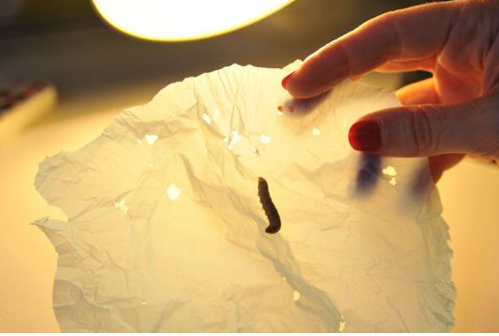
A caterpillar(毛毛虫) that eats on plastic bags could hold the key to solving plastic pollution, scientists say. Researchers at Cambridge University have discovered that the caterpillar which eats beeswax(蜂蜡), can also degrade(降解) plastic.
Experiments show the insect can break down the chemical bonds(化学键) of plastic in a similar way to digesting beeswax. Each year, about 80 million tons of the plastic are produced around the world. The plastic is used to make shopping bags, food packaging, one-off raincoat and other things, but it can take hundreds of years to degrade completely.
However, caterpillars can make holes in a plastic bag in less than an hour. “The caterpillar will be the starting point. We need to understand the details under which this process operates. We hope to provide the technical solution to cutting down the problem of plastic waste,” the scientist said. And the scientists who discovered it want to speed up the process of discovering the chemical secrets behind the natural degradation(降解) of plastic. They think something in the caterpillar—as well as the insect itself—might play a role in breaking down plastic.
If the chemical process can be found out, it could lead to a solution to managing plastic waste in the environment. “We are planning to use this finding in a practical way to get rid of plastic waste, working towards a solution to saving our oceans and rivers,” said the scientist. “However, we should not feel good to dump plastic on purpose in our environment just because we now know how to degrade it.”
1.Why is the caterpillar thought to be the key to solving plastic pollution?
A It is fed on beeswax.
B It can be used in experiments.
C It can degrade plastic.
D It makes no waste.
解析:选C。C 细节理解题。根据第一段内容可知,科学家们之所以把毛毛虫当成解决塑料污染的关键,原因在于毛毛虫能够吃蜂蜡并降解塑料,故选C。
2.What don’t people use plastic for?
A Shopping bags.
B Food packaging.
C One-off raincoats.
D Caterpillars’ food.
解析:选D。D 细节理解题。根据第二段最后一句“The plastic is used to make shopping bags, food packaging, one-off raincoat and other things, but it can take hundreds of years to degrade completely.”可知,塑料可用于做购物袋、食品包装及一次性雨衣,没有提到用于做毛毛虫的食物。故选D。
3.What are scientists trying to find out?
A How the caterpillars live.
B How the caterpillars degrade plastic.
C Why plastic can be degraded.
D What the caterpillars feed on.
解析:选B。B 推理判断题。根据第三段的第二三句可知,科学家们想弄清楚毛毛虫降解塑料过程的具体情况,也就是毛毛虫是如何降解塑料的。故选B。
4.What does the underlined word “dump”probably mean in Chinese?
A 购买.
B 售卖.
C 扔掉.
D 降解.
解析:选C。C 词义猜测题。该词所在句表达的意思是“我们不能因为知道了如何降解塑料就觉得随意乱丢塑料垃圾是正当的”,由此推断这里的dump应该是“扔掉”的意思,故选C。
5.What is the best title of this passage?
A How caterpillars degrade plastic.
B Scientists are working towards plastic degradation.
C Scientists have found the chemical process.
D Caterpillars may help to solve plastic pollution.
解析:选D。D 文章标题题。根据全文内容:毛毛虫可以降解塑料,因此可能是解决塑料污染的关键点,可知本文的中心思想是毛毛虫可能帮助解决塑料污染问题,故选D。